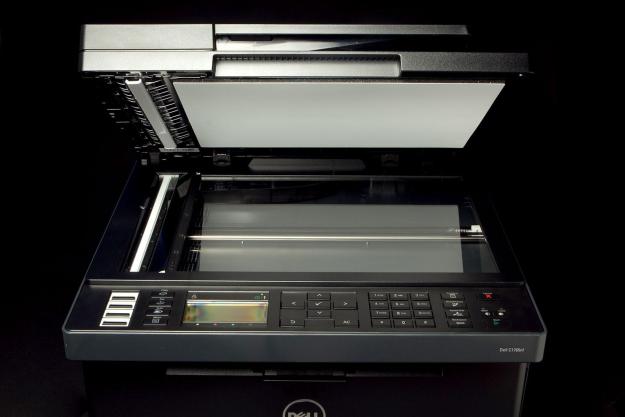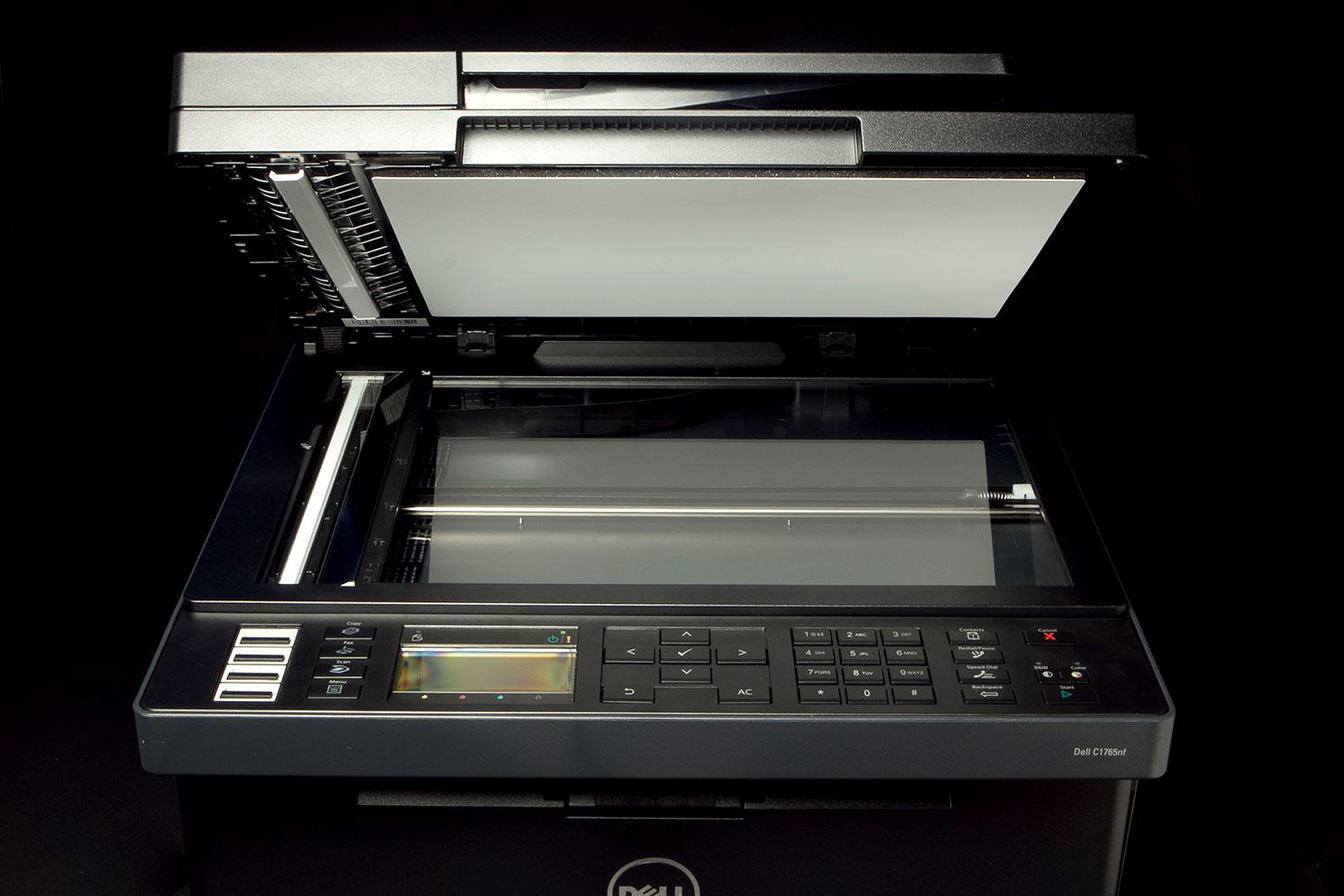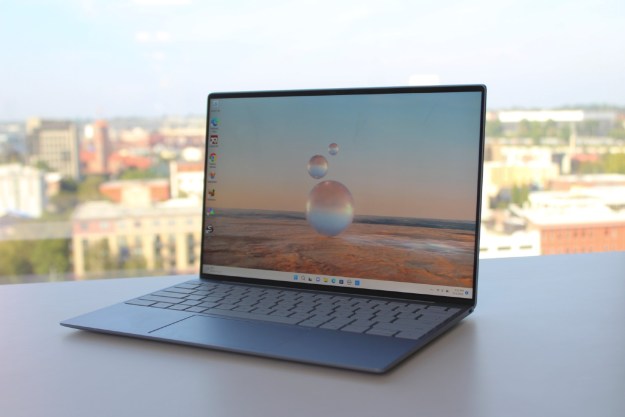
“Overall, the C1765nf is a great all-around printer, even for home use. You can print reports and homework quickly, and image quality on documents – while not photo quality – is excellent for other use.”
- Good speed
- Very good output quality
- Automatic document feeder
- PaperPort utility included
- No Wi-Fi in this model
- No automatic duplexer
- Supplies are expensive
- Can’t print on certain papers
You probably know Dell for its laptops, desktops, and servers, but the company has also been selling printers for years, like the C1765nf Color Multifunction Printer (MFP). Take one look at the unassuming black box design, and you might say, “It’s a laser printer, big deal.” That’s where you’d be wrong. You won’t find the word “laser” in anything describing the C1765nr because it isn’t one, nor is it an inkjet. Rather, it’s an LED printer.
LED printers aren’t new – OKI has been making them for a while. An LED printer is almost identical to a laser printer in function: It uses light to scan a photoconductor onto which toner is transferred to before being deposited onto a piece of paper. But instead of a laser beam directed to a specific spot by a rotating mirror, an LED printer uses a fixed array of LEDs that span the entire width of the print area, which is 8.5 inches in a letter or legal size printer. There’s no real noticeable difference in the output between a laser printer and an LED printer, but the LED printer is mechanically simpler.
Features and design
Some of the inkjet MFPs we’ve reviewed recently have adopted a sleek, almost high-end audio appliance appearance. That’s not the case with the C1765nf. It looks pretty much like most office MFPs, though its black case and square lines do make it an attractive addition to a small or home office.
For a reasonably priced MFP, the Dell 1765nf provides a lot of value.
The C1765 comes in two models: the C1765nf, the model we tested, provides USB and 100BASE-T Ethernet connectivity, while the C1765nfw adds Wi-Fi connectivity and about $30 to the price tag. Both models come with Nuance’s PaperPort 14, an entry-level document management utility which provides PDF reader functionality.
At 16.1 x 14.9 inches, the C1765nf is a bit larger than some of the inkjet all-in-ones (AIO) we’ve tested – it’s the 13.3-inch height that makes it seem much larger and bulkier. Weighing a bit over 31 pounds, you’ll probably want to place the C1765nf somewhere other than your desktop and plan on not moving it around much.
The C1765nf is easy to set up and use. It comes with the starter toner cartridges preinstalled, but changing them is as simple as opening the right side panel, pulling the used cartridge out, and inserting a new one.
The controls are located on a panel that sticks out near the top of the front side. This panel contains a small monochrome LCD that presents toner levels, and using a four-direction set of arrows next to the display lets you scroll through various menus and submenus to set functions such as copy options.
To the left of the LCD there are two sets of buttons – typical for a business-centric MFP. The leftmost four-button vertical stack is for using one-touch dialing when faxing. Next to it, between the one-touch buttons and the display, are another four buttons in a vertical stack that select the function you want to use – Copy, Fax, and Scan, with the bottom button bringing up the menu on the display. Also on the control panel is a keypad for entering fax numbers or number of copies, a Color Mode button to select color or black and white printing, and a Start button to start copying or dialing a fax.
The C1765nf has room at the bottom of the unit to insert up to 150 sheets of letter or legal size paper, and directly above that is a second fixed tray, which Dell calls an “Inserter,” to feed specialty media such as heavier stock, letterhead, envelopes, or sheets of labels. Photo paper is not supported, nor is paper designed specifically for inkjet use (read on to find out more about paper). The printed output exits via a slot directly under the control panel.
Scans and faxes can be accomplished using the glass platen under the flip-up top, or the 15-page ADF built into the cover.
What’s in the Box
There are not a lot of extras included in the packaging – BYO USB cable. The MFP comes preloaded with the four color toner cartridges. Also included is a power cord, phone cord for fax, a large setup poster, a four-page guide, and a CD containing the print and scan drivers for Windows and Mac OS X, and PaperPort 14 from Nuance. A large 376-page user manual (PDF file) is included as part of the installation and is accessible from the status screen displayed on the PC when printing.
PaperPort is a really useful utility, and makes it easy to scan and store documents, create PDFs, and serve as a substitute for Adobe Reader. Nuance charges $99 for this utility, and its inclusion with the C1765nf really adds value.
Performance and Use
Setup was easy and completely automated. It took about 10 minutes to completely install the drivers and PaperPort 14 software using a USB cable. The quick start poster and four-page guide are sufficient for the instructional task.
Although it isn’t meant for printing photos, the colors, detail, shadows, and saturation of images were accurate.
We were pleasantly surprised when we started testing the C1765nf. Dells claims a speed of up to 12ppm for color printing, and that’s just about what we achieved when printing on letter-size paper.
While there is no special paper that Dell recommends, Dell does warn you not to use certain papers such as those specifically meant for inkjet printers. We tested image quality using two different papers – the Hammermill Premium Inkjet and Laser paper we use for all our tests, and HP Office Paper. Output quality on both papers was almost identical, with the less expensive Office Paper giving just slightly better results that were only noticeable when the prints were compared side-to-side.
Comparing prints on the Hammermill and HP papers to our reference prints, the colors and saturation on both papers were very accurate. The photograph we use as one of our three test images didn’t have the vividness of a photo printed on glossy photo paper, but the colors, detail, shadows, and saturation were accurate. While it isn’t a photo printer – you should get a sub-$100 inkjet if you print photos occasionally – images on documents look good.
Making copies with the C1765nf was not the “watching the grass grow” experience that copying on most inkjet printers entails. Put an original in the ADF or on the platen, press the Copy button, enter the number of copies desired, and use the Color or Black buttons on the control panel (why waste color toner if you don’t need a color copy), and you’re off to the races.

Scanning is just as easy, and you can scan into PaperPort, scan to an e-mail, scan to a USB drive plugged into the front panel port, or import a scan into any application that supports the scanner’s TWAIN driver. We were able to scan and import a test document directly into Picasa and the default scan quality, 300 dpi, produced very useable scans.
Our big complaint is one that applies to a lot of printers, whether inkjet, laser, or, like the C1765nf, LED: the cost of supplies. Dell offers toner cartridges in a standard size – with all colors yielding about 700 pages – for $50 for the black cartridge and $56 for each color cartridge. Large capacity cartridges are even more expensive, costing $70 each. The large-capacity black cartridge is estimated to yield about 2,000 pages, with the color cartridge yielding about 1,400 pages.
At $70 a cartridge, a complete set of the four high-capacity cartridges is almost the same price as the MFP initially costs. Again, it isn’t uncommon for a set of ink or toner to approach the initial printer or MFP cost, but it does hurt when replacement time comes around.
Conclusion
For a reasonably priced laser-like MFP, the Dell 1765nf provides a lot of value. While small office/home office centric, it is a useful device even for general home use. Output quality is very good. The C1765nf not only prints copies at a reasonable and useful speed, but the ADF make copying or faxing multipage documents a breeze.
Two things this particular model lacks are Wi-Fi connectivity and a duplexer. The C1765nfw model provides Wi-Fi connectivity as an option to the standard USB and Ethernet, which adds about $30 to the price, but automatic duplexing is not available on either model.
What to watch out for is the type of paper you’ll be using. Dell warns against using paper intended for inkjet printing, and most coated papers, like photo paper, are also a no-no.
Highs
- Good speed
- Very good output quality
- Automatic document feeder
- PaperPort utility included
Lows
- No Wi-Fi in this model
- No automatic duplexer
- Supplies are expensive
- Can’t print on certain papers
Editors' Recommendations
- The 10 best monitors for 2024: tested and reviewed
- 10 best gaming monitors of 2024: tested and reviewed
- Best color laser printers for 2024: tested and reviewed
- 9 best laptops of 2024: tested and reviewed
- Best Dell laptop deals: Cheap laptops starting at $280






